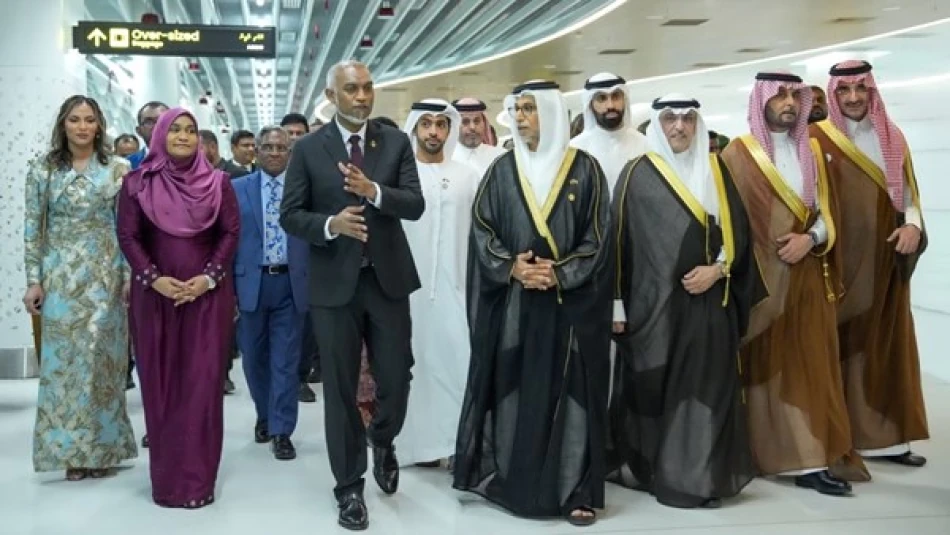
Abu Dhabi Development Fund Inaugurates Feydhoo International Airport in Maldives
UAE-Led Investment Coalition Transforms Maldives Aviation Hub in $90M Infrastructure Push
The Maldives has officially opened its upgraded Velana International Airport, a transformative infrastructure project backed by a coalition of Gulf development funds led by Abu Dhabi. The $90 million initiative more than doubles the airport's capacity to 7 million passengers annually, positioning the island nation as a major aviation hub in the Indian Ocean while demonstrating how regional development banks are reshaping emerging market infrastructure financing.
Strategic Timing Aligns with Tourism Recovery
The airport's inauguration coincided with the Maldives' 60th independence anniversary, but the timing carries deeper significance for the tourism-dependent economy. As global travel rebounds from pandemic lows, the Maldives needed expanded capacity to capture growing demand from high-spending tourists, particularly from China and India. The upgrade arrives as the country targets 2 million annual visitors by 2025, up from 1.7 million in 2023.
The expanded facility features 26 passenger boarding gates and a new international terminal, addressing chronic bottlenecks that previously limited growth. For an economy where tourism accounts for roughly 60% of GDP, these infrastructure constraints represented a significant competitive disadvantage against regional rivals like Sri Lanka and Thailand.
Gulf Development Finance Model Gains Momentum
The project showcases an increasingly common financing structure where multiple Gulf development funds pool resources for strategic infrastructure investments. Abu Dhabi Development Fund contributed 330.5 million dirhams ($90 million) across two phases, while the Saudi Development Fund, Kuwait Fund for Development, and OPEC Fund for International Development provided additional backing.
This collaborative approach mirrors successful models used in Africa and Southeast Asia, where regional development banks reduce individual risk exposure while maximizing impact. Unlike traditional Western development finance, Gulf funds often move faster with fewer bureaucratic hurdles, making them attractive partners for countries seeking rapid infrastructure upgrades.
Investor Implications
For aviation and tourism investors, the upgrade signals the Maldives' commitment to capturing premium market segments. The expanded capacity should support higher-margin routes and reduce operational constraints that previously limited airline scheduling flexibility. Hotel developers and resort operators benefit from improved accessibility, potentially justifying higher room rates and occupancy targets.
Deepening UAE-Maldives Economic Integration
The airport project represents the latest chapter in a 45-year development partnership between Abu Dhabi and the Maldives, dating to 1978. The UAE has now funded 11 strategic projects worth 1.11 billion dirhams ($302 million) across transportation, healthcare, energy, and tourism sectors.
This relationship extends beyond traditional aid, reflecting the UAE's broader strategy of building economic influence across key maritime routes. The Maldives' strategic position along major shipping lanes between Europe and Asia makes it valuable for trade facilitation and regional connectivity.
President Mohamed Muizzu's attendance at the opening ceremony, alongside senior UAE officials, underscores the political importance both sides place on the partnership. For the Maldives, diversifying development partnerships reduces dependence on any single major power, while the UAE gains influence in a strategically located ally.
Regional Competition for Infrastructure Influence
The project occurs amid intensifying competition for influence in the Indian Ocean region. China has invested heavily in Maldivian infrastructure through its Belt and Road Initiative, while India maintains close security and economic ties with the archipelago nation.
Gulf states like the UAE offer a middle path—significant financial resources without the geopolitical complications that sometimes accompany Chinese or Indian involvement. This positioning has proven attractive to smaller nations seeking development finance while maintaining strategic autonomy.
The collaborative funding model also demonstrates how regional powers can coordinate rather than compete destructively for influence, potentially offering a template for future infrastructure projects across the developing world.
Most Viewed News

 Layla Al Mansoori
Layla Al Mansoori






